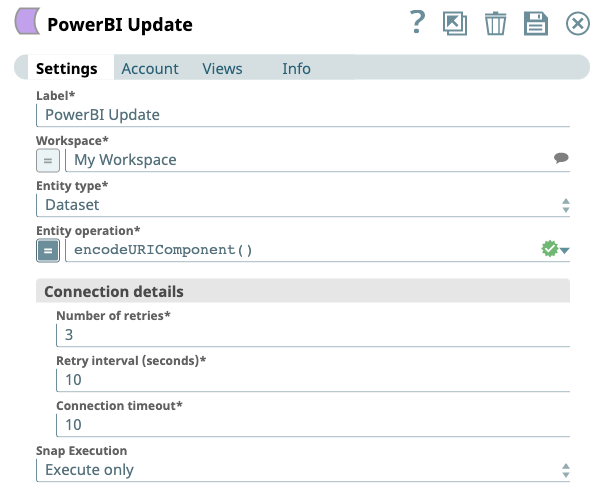In this article
Overview
Use this Snap to update datasources.
Prerequisites
None.
Support for Ultra Pipelines
Works in Ultra Pipelines.
Limitations
None.
Known Issues
None.
Snap Input and Output
| Input/Output | Type of View | Number of Views | Examples of Upstream and Downstream Snaps | Description |
|---|---|---|---|---|
| Input | Document |
|
| A document containing the ID of the entity to update along with the data to update. |
| Output | Document |
|
| A document containing details of the updated entity. |
Snap Settings
| Parameter Name | Data Type | Description | Default Value | Example |
|---|---|---|---|---|
| Label | String | Specify a name for the Snap. You can modify this to be more specific, especially if you have more than one of the same Snap in your pipeline. | Power BI Update | Update Employee Record |
| Workspace | String | Required. Enter the workspace in which to update the resource. Alternatively, click the icon to fetch a list of workspaces associated with the Power BI account and select the workspace. | My Workspace | Employee Records |
| Entity type | String | Required. Select the entity type to update. Available options are:
| Dataset | Report |
| Entity operation | String | Select the update operation to perform. The available options vary upon your configuration of the Entity type field. Alternatively, you can also enter the operation's name manually. The available options are:
| N/A | Update Datasources |
| Connection details | Use this field set to configure the network connection parameters. This field set consists of the following fields:
| |||
Connection timeout | Integer | Required. Specify the connection timeout duration in seconds. | 0 | 30 |
Number of retries | Integer | Required. Specify the maximum number of re-connections if the connection fails or is timed-out. | 10 | 4 |
Retry interval (seconds) | Integer | Required. Specify the interval in seconds between reconnections. | 10 | 30 |
| Snap Execution | String | Specifies the execution type:
| Execute only | Validate & Execute |
Troubleshooting
| Error | Reason | Resolution |
|---|---|---|
| HTTP Response Exception:400 | Invalid OAuth endpoint/token URL. | Verify the values of the OAuth2 endpoint or token URLs in the account settings. |
| HTTP Response Exception:401 | Invalid refresh token or access token. | Verify the values of the refresh or access tokens in the account settings. |
| HTTP Response Exception:409 | Conflict | Verify the network and Snap settings. |
Property value is missing. | Your input for 'Workspace'/'Entity id' is missing. | Required fields cannot be blank. Verify whether you have configured all required fields correctly. |
Examples
Updating a Dataset's Refresh Schedule
We want to update a specific dataset's refresh schedule. This Pipeline demonstrates how we can use the Power BI Update Snap to accomplish this task.
To update any resource, we need:
- The resource's identifier, or entity ID, and
- The data to update, in this case, the refresh schedule
Since we do not have the entity ID, we use the Power BI Read Snap to first retrieve the entity's details. Otherwise, we can just include the entity's ID along with the data to update.
We configure the JSON Generator Snap to output the latest refresh schedule that we want to update. The screenshot below shows this data:
The outputs from the Power BI Read and JSON Generator Snaps are joined using the Join Snap. The Join Snap's output, which is the entity ID from the Power BI Read Snap and the updated refresh schedule from the JSON Generator Snap, are sent to the Mapper Snap.
We need the Mapper Snap to map the data to its corresponding fields in the dataset's schema. Accordingly, we configure the Mapper Snap as shown below:
Lastly, we add the Power BI Update Snap to the Mapper Snap's output. We configure the Power BI Update Snap based on our requirements as shown in the screenshot below:
Upon successful execution, the Power BI Update Snap updates the target dataset with the updated data.
Downloads
Important steps to successfully reuse Pipelines
- Download and import the Pipeline into SnapLogic.
- Configure Snap accounts as applicable.
- Provide Pipeline parameters as applicable.
